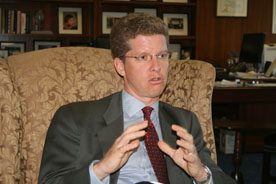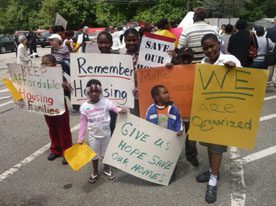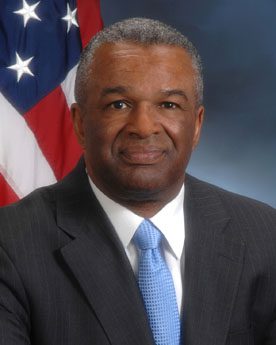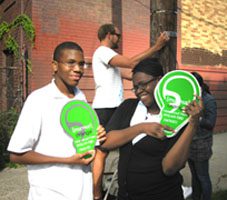
HUD Secretary Shaun Donovan
One needs to look no further than the U.S. Department of Housing and Urban Development to find change in Washington. HUD was an agency that had long been criticized as a boutique agency lacking a central urban policy and wrought with distractions — so much so that Kermit Lind, a Cleveland State University law professor who specializes in housing issues, observed when Shaun Donovan was selected to lead the agency that it was “not often you see the word competent and HUD in the same sentence.”
Donovan came into this post wearing his New York City portfolio on his sleeve. Plucked from the city’s Department of Housing Preservation & Development, his selection alone to lead the agency provided an indication that the newly elected president was trying to make HUD into a relevant, powerful agency. Donovan helped to implement New York City Mayor Michael Bloomberg’s 10-year, $7.5 billion New Housing Marketplace Plan, which is the largest municipal housing plan in the country and a model for how to create and preserve affordable housing for cities across the country, as well as helping to oversee the New York City Acquisition Fund, $200 million that allows access to capital for the affordable housing industry. The fund helps nonprofit and local developers acquire property for affordable housing construction and preservation.
Donovan sat down with Shelterforce in October 2009 in his Washington office to discuss a changing agency, the evolving role of nonprofits, and the ongoing housing challenges facing the country: “while I think we are making progress, we have a long way to go.”
Shelterforce: How did your time at New York City’s Department of Housing Preservation and Development (HPD) prepare you for your tenure at the U.S. Department of Housing & Urban Development?
Shaun Donovan: I learned that the success of a neighborhood is intimately tied to the web of activity on the ground, and that understanding has really helped to inform a lot of the work that we’ve started to do around here, including [the HUD/DOT] Sustainable Communities Initiative.
At HUD, there’s an incredible sense of opportunity working outside of just the housing field and with other agencies. One of the things I enjoyed the most about — and learned the most from — the experience with the Bloomberg administration was whether it was the plan to end chronic homelessness in New York, whether it’s PlaNYC, the city’s sustainability plan, the most inspiring and exciting efforts really only happened because of strong leadership from City Hall and a collaboration across agencies. It wasn’t just HPD: it was the city planning department, the transportation department, the Economic Development Corporation, and so on, and fitting all of those pieces together that made that possible.
And I think what it has taught me is that we can only achieve our broader housing goals within the context of achieving healthier neighborhoods and cities and more sustainable places that HUD alone can’t create. So, I think those were two very important lessons taken from HPD that have helped me, along with real leadership from the White House. We’ve started to form those collaborations and think about how HUD can be a presence in those discussions on the ground.
Let’s face it: “UD” in HUD has been missing for a long time, and so we really have to re-engage with all of the things that contribute to urban development, not just the field of HUD’s own programs themselves. When you have a scenario on the ground that has a lack of flexibility and leadership, a sense of frustration arises, and I don’t know that New York can — or if any one place can — prepare you for trying to design a set of housing policies for the entire nation. I’ve now been to, I think, 27 states since I started, and to spend time on the Bering Sea in Alaska in a village of a thousand native Alaskans and then to go to the Northern Cheyenne Reservation in Montana presents a completely different experience. It is a big country, literally and figuratively, and we need to act with as much flexibility as possible.
Over time, HUD has been so concerned about just making mistakes and has pulled so much authority into the field, what we need to do, organizationally, is to rebuild a strong leadership presence in the field and really give authority to those folks in the field to customize solutions for local communities. While I saw that in my own experience in New York, it’s been amplified by my experience of seeing the diversity of challenges, but also, frankly, the lack of authority in existing leadership.
There’s an enormous amount of excitement right now within HUD about the opportunities that we have under our president, who has worked in public housing himself, a team now at HUD that are “housers,” and lots of people here who came to HUD to change the world.
And while there’s real excitement about that, the question we have to ask is: How do we create the structures that allows HUD to customize and frame solutions in local communities that match community development needs on the ground? That’s going to be a big part of what we’re in the process of answering as we transform the agency. [HUD Deputy Secretary] Ron Sims has been very focused on this, spending a lot of time with the field offices trying to figure out how we mature, that we get more authority out of the field to help solve local problems.
The second round of the Neighborhood Stabilization Program encourages cross-municipality, regional work, but things like Community Development Block Grants focus on a local unit of government. So, you have funding streams that seem to work antagonistically with some of the larger program initiatives. How do you square it all?
With CDBG, we have to walk before we can run. Take the issue of sustainable communities, for example, and the kind of coordinated housing/transportation/environmental planning that needs to happen to create the kind of collaboration that you’re talking about. A lot of cities in this country are doing really interesting work on that end, and it’s not just places like New York, Denver, Seattle, and Chicago.
We’ve been out traveling with the Office of Urban Affairs, with Secretary Ray LaHood from the Department of Transportation, with EPA Commissioner Lisa Jackson, Energy Secretary Steven Chu, and a range of others, in really seeing examples of this in places including Dubuque, Iowa, and Kansas City, Mo.
I think the way that we framed it is that the Sustainable Communities Initiative, which is part of CDBG, is a way for us to begin to both support the innovation that’s already out there, but also to create, through federal funding, real incentives for a broader set of places to start to do that kind of planning. I think, in the longer run, as we both fund and conduct research on building a set of models out of sustainable communities as an initiative, we can come back to the consolidated plan and figure out how we change the fundamental requirements that apply to everyone for CDBG so that we get the same kind of outcomes that we’re looking for.
Look, if we jumped right to saying, “Let’s just change the consolidated plan,” what models would we use? What works not just for large cities, but for small cities in rural places? This is work that has to be carefully crafted, and we see sustainable communities as the first step towards broader reform that would cut across the entire program.
So, there is a kind of longer-term arc that we see here towards getting to what you’re talking about, but I don’t think we should pretend that the federal government has the experience or the models yet. That’s why we see sustainable communities as such an important sort of first step in building the knowledge base and building a set of different models out there that we can then begin to build on.
You use phrases like “building the knowledge base.” I don’t know if you used it, but certainly evidence-based. So many programs in the past have been “ready-fire-aim,” and maybe they were good programs —
[Donovan] Or “ready-fire.”
Certainly. All of those programs had elements that were very important, but the unintended consequences and the way they played out just didn’t work. Talk about how this has changed, or how you and your senior staff are working to change this.
I think there is an enormous amount of work that needs to be done around actually measuring what we do. We have to make sure that it is actually meeting the goals that we intended. And as part of that transformation initiative, beyond just proposing a significant increase in funding for policy development and research, is bringing in tremendous leaders like Assistant Secretary for Policy Development and Research (PD&R) Raphael Bostic and Erika Poethig (deputy assistant secretary for PD&R) to work with the existing strength of the team here that’s being built on and expanded.
I think we have a huge opportunity to have HUD be a knowledge center for the country and to really drive research.
But then there is a much broader frame of what I would call “performance-based thinking” that has to come to the department. In New York City, for example, the incredible power of saying, from the mayor to everyone through the city, “What’s the city’s housing goal? It’s 165,000 units preserved and built over 10 years,” the power of organizing — not just inside government but also outside government — around fairly simple numeric goals is incredibly powerful.
Clear, ambitious goals for what the department is going to accomplish are not just words. When it comes down to things that you can measure, I’m a strong believer that you’ll have positive outcomes.
But what I need to do as a leader is to make sure that everyone understands that. It’s why we’ve built a strategic planning and management team here. We’re working with the White House and the chief performance officer to create a whole system to measure metrics. We’ve started a strategic planning process that’s going to try to get to clear goals with metrics for each of those. So, there’s a whole broader effort that is around that kind of accountability which goes just beyond research and evaluation, which I think is equally important to having evidence-based policymaking, as well.
It really does require a feedback loop.
At Shelterforce, we’ve been writing about the crisis in rental housing since 1975. While we haven’t heard that much about it from Washington in recent years, we have heard that “we need to deal with this” more than once. What’s different this time? And how will a policy that balances ownership and rental really play out?
Also, when we speak about low income rental housing, it’s usally about subsidized housing, but upwards of 60 or 70 percent of the rental housing that low-income families live in is non-subsidized, mostly small rental apartments, which we know very little about. How do you take into account the private rental market when addressing the larger issue of the balanced housing policy?
We need to answer this on two levels. First, let’s talk about the rental programs themselves. To put it as simply as I can, we now know how to make affordable rental housing work. There is a body of expertise and success that’s been built up around the country. New York is one of them, but there are lots of places around the country where we have success that didn’t exist 10 or 20 years ago.
Second, I think there’s both the perception of failure of the public housing efforts, but also the reality. I think we’ve built up such a body of more sophisticated experience around not just tax credits and vouchers, but also the interplay between them, that we now have a set of models that I think can work extremely well.
And part of that goes back to the point about bringing the market to affordable housing. How do you make sure that affordable housing is not a sort of world unto itself that exists alongside but separately from the rest of the housing market?
One of the most interesting developments I worked on in New York was a supportive housing project with market rate condominiums and a bunch of other types of housing in between in the South Bronx, where there’s a certain sensibility about how to make affordable housing work so that, ultimately, in some ways, no one knows it’s there. It blends seamlessly into the broader housing market and into the neighborhoods surrounding it. But in many cases, that project would be way too hard to do, in part thanks to HUD. The complexity of programs, the barriers that we put in the way of doing that, the number of different sets of regulations — we’ve now counted them: 11 different deep subsidy programs at HUD run by three different divisions with 6,000 employees. And, that’s not even including the tax credit, right? So, there’s an enormous amount of work to do to say “How do we bring these 20th century tools into the 21st century” and respond to a lot of the innovation and what we’ve learned on the ground.
This administration understands, and I very personally understand, that rental housing is rooted in a larger market and a larger metropolitan and rural framework.
I think we have some momentum at our backs in that there’s a growing recognition that cities are successful engines of growth and vitality in the country. Meanwhile, suburbs have started to grow more like cities, and subsequently have some of the same problems and challenges of cities. People aren’t thinking about how “the city is dying” anymore: I grew up in New York City, and I remember during the 1977 World Series when Howard Cosell said, “Ladies and gentlemen, the Bronx is burning.” That was sort of my framework as a child, growing up.
There were lots of people in the country who thought that cities were dying, and that they were not our future. But now, I think we’re experiencing a fundamental shift in understanding that density and the vital, mixed income/mixed use neighborhoods that accompany density, are successful. Moreoever, I also think we understand that there are lots of components to making that work that go well beyond just how we support rental housing with subsidy programs at HUD. And I think zoning is the most important example there.
And there are important questions about the best way for the federal government to support those efforts locally. One of the things that we’re trying to do with the sustainable communities initiative is to find and support best practices around zoning and other land use that is a critical part of creating not just a subsidized housing infrastructure, but also a market-based affordable housing infrastructure — and that’s certainly the case in New York, and a big part of the mayor’s housing plan effort was using all of the urban development tools to try to get a balanced housing policy that includes rental and ownership, as well as including a whole range of different income levels.
We have the tools to go beyond just the traditional rental program. For example, we recently made a change to our FHA multifamily programs that allowed state-of-the-art environmental remediation techniques to be used. Why is that a big deal? Because we haven’t been able to support urban infill development — or even suburban infill development — in so many cases. And because we didn’t have state-of-the-art environment techniques, that pushed our support into more greenfield sites that weren’t connected to transit.
So, there’s a whole set of things like that where we can take barriers out of the way of making sure that we’re doing the things that would support market provision of rental housing in places that are more sustainable. We also realize the importance of affirmatively furthering fair housing to support the broader development of mixed income/mixed use neighborhoods in lots of different kinds of settings.
The administration has taken several steps to address the foreclosure crisis, but it’s still a huge crisis.
When we came into office, there were literally millions in the midst of foreclosure and after too many years of the federal government not taking responsibility for the issue we’ve embarked on what is really the largest federal effort ever to intervene in the foreclosure crisis moving to the point where we’ve recently reached half a million modifications almost a full month ahead of the target that we had set. We’ve seen other positive signs like home sales increasing and home prices up over the past three months that point to broader signs of the stabilization of the market.
So, while I think we are making progress on foreclosures, we have a long way to go. There’s no question about it. We’re meeting with the servicers to push them more.
In cases of shared equity homeownership and community land trusts, there have been very few instances of foreclosure, which is not well known. These models offer benefits like permanent affordability and opportunities for people to become homeowners who would otherwise not have that chance. What is the role of these in the housing continuum, and how do you bring them to scale?
There are some fundamental things that have been done right in models like shared equity and land trusts, but also many other ways of helping low- and moderate-income people become homeowners. The lesson we can’t take from the foreclosure crisis is that low- and moderate-income people can’t be successful as homeowners. When I left New York, we had created or preserved about 17,000 units of home ownership in the mayor’s housing plan. We had five foreclosures among those 17,000.
The lesson is that if you do it right, it can be incredibly successful. And part of that is figuring out ways where you ensure that the home is affordable, actually affordable to somebody, so that they get the right kind of mortgage product, the right counseling, or whatever they need, and then ensuring that those mechanisms become widespread. I think this is exactly the kind of thing that HUD ought to be doing. You talk about evidence-based policy: we ought to be building the capacity, and to research and write about these kinds of efforts, and then try them at scale.
Again, in New York, we created a home ownership inclusionary zoning program that was fundamentally a shared equity model that included permanent affordability. There are a lot of those types of efforts around the country and we ought to be researching them, figuring out where they’ve worked, what models work best, and, at the very least, sharing those models.
Right now, the CDC model itself is being challenged as the community development world changes. How do you see the role of CDCs?
I guess I see it somewhat differently. I think part of the issue is that, if you think about what the most important development over the last quarter or even half-century in the broader field of housing and community development is, it is the evolution of this third sector that lives between the traditional private sector and the public sector.
And as I see it, the accomplishments of the CDC sector are enormous. I mean, today, they are our most creative housing developers, they’re in many neighborhoods, and are often the most important civic institutions in those communities where churches or other forms of traditional civic institutions have faded away. I think that one of the ways we have to bring HUD’s programs into the 21st century is to build in a role for those organizations more explicitly.
Part of the issue is, how do we support those kinds of institutions more systematically, more structurally, through our programs, from things as simple as the fact that a lot of our programs say nonprofits can’t earn profits. If that organization is restricted by law from taking money and putting it into charitable purposes, that it’s going to go back into the neighborhood, why wouldn’t we allow them to build equity the same way that a for-profit does? There are more simple things like that.
But then, more broadly, many CDCs are not even eligible for many of our programs. One of the things that was so important about our Choice Neighborhoods Initiative was that it allows nonprofits to come in as the lead applicants for the program. We also have to think about technical assistance differently. It isn’t just about us helping to fill out your forms, but about how we can really help to build the capacity of those organizations to survive the economic crisis.
Further, CDCs need to build strength in places where they haven’t traditionally been, and one of the things about the foreclosure crisis that’s striking to me as I travel around the country is the concentration of foreclosures occurs really in what I would describe as the least sustainable places: not connected to transit, not connected to mixed income/mixed use neighborhoods, and outside of places with traditional CDC networks. The challenge is to find how one can adapt the more urban kind of traditional CDC model to suburban communities, to places where organizing — replete with all the traditional tools — is just different. What is the new model for a suburban CDC? There’s a whole set of questions like that, I think, that are important.
I also think there has to be some willingness to take a hard look at where CDCs aren’t successful. Should we be looking at regional collaborations? Should we look at merging CDCs and trying to grow their reach? Another model includes the kind of regional organizations that have grown up in the housing field. Carol Galante, deputy assistant secretary for Multifamily Housing Programs at HUD ran BRIDGE Housing Corporation, and you wouldn’t think of it as a traditional neighborhood-based community development corporation. It works in a very broad area, but it’s a vital third sector entity. CDCs have to be willing to evolve and change as the challenges evolve and as the sector matures, and I think there are a number of existing models out there.
Thank You.





Comments